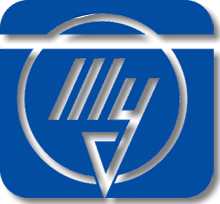VASO in English, ВАСО Ilyushin Il-2 Sturmovik
 |
|
| A Soviet Air Force Ilyushin Il-2M in flight | |
| Role | Ground-attack aircraft |
|---|---|
| National origin | Soviet Union |
| Design group | Ilyushin |
| Built by | Factory 381 State Aviation Factory 18 |
| First flight | 2 October 1939 |
| Introduction | 1941 |
| Retired | 1954 (Bulgarian Air Force & Yugoslav Air Force) |
| Primary users |
Soviet Air Force
|
| Produced | 1941–1945 |
| Number built | 36,183 |
| Developed into | Ilyushin Il-10 |
.
History Voronezh Aircraft Production Association
Ilyushin Il-2 Shturmovík "The Bark"

The Ilyushin Il-2 (Russian: Илью́шин Ил-2) is a ground-attack plane that was produced by the Soviet Union in large numbers during the Second World War. The word shturmovík (Cyrillic: штурмовик), the generic Russian term for a ground-attack aircraft, became a synecdoche for the Il-2 in English sources, where it is commonly rendered Shturmovik, Stormovik[3] and Sturmovik. To Il-2 pilots, the aircraft was known by the diminutive "Ilyusha". To the soldiers on the ground, it was called the "Hunchback", the "Flying Tank" or the "Flying Infantryman". Its postwar NATO reporting name was Bark. During the war, 36,183 units of the Il-2 were produced, and in combination with its successor, the Ilyushin Il-10, a total of 42,330 were built, making it the single most produced military aircraft design in aviation history, as well as one of the most produced piloted aircraft in history along with the American postwar civilian Cessna 172 and the German then-contemporary Messerschmitt Bf 109.
Design and development
Origins

The idea for a Soviet armored ground-attack aircraft dates to the early 1930s, when Dmitry Pavlovich Grigorovich designed TSh-1 and TSh-2 armored biplanes. However, Soviet engines at the time lacked the power needed to provide the heavy aircraft with good performance. The Il-2 was designed by Sergey Ilyushin and his team at the Central Design Bureau in 1938. TsKB-55 was a two-seat aircraft with an armoured shell weighing 700 kg (1,500 lb), protecting crew, engine, radiators, and the fuel tank. Standing loaded, the Ilyushin weighed more than 4,700 kg (10,400 lb), making the armoured shell about 15% of the aircraft's gross weight. Uniquely for a World War II attack aircraft, and similarly to the forward fuselage design of the World War I-era Imperial German Junkers J.I armored, all-metal biplane, the Il-2's armor was designed as a load-bearing part of the Ilyushin's monocoque structure, thus saving considerable weight. The prototype TsKB-55, which first flew on 2 October 1939, won the government competition against[] the Sukhoi Su-6 and received the VVS designation BSh-2 (the BSh stood for "Bronirovani Shturmovik" or armoured ground attack). The prototypes – TsKB-55 and TskB-57 – were built at Moscow plant #39, at that time the Ilyushin design bureau's base.
0
KmCeiling
0
KmCombat RANGE
0
Km/hAircraft Speed
0
Max Crew
Photo Gallery
Voronezh Aircraft Production Association
Ilyushin II-2 Shturmovík "The Bark"


Voronezh Aircraft Production Association
Ilyushin II-2 Shturmovík
General Info
-
-
-
- Crew: 2
- Length: 11.65 m (38 ft 3 in)
- Wingspan: 14.60 m (47 ft 11 in)
- Height: 4.17 m (13 ft 8 in) (tail up)
-
-
Powerplant
-
-
-
- Powerplant: 1 × Mikulin AM-38F liquid-cooled V12 engine, 1,280 kW (1,720 hp) (takeoff power),1,100 kW (1,500 hp) at 750 m (2,460 ft)
- Propellers: 3-bladed AV-57-158 variable-pitch propeller, 3.60 m (11 ft 10 in) diameter
-
-
Performance
- Maximum speed:410 km/h at 1,500m
- Range: 765 km (475 mi, 413 nmi) at 275 km/h (171 mph; 148 kn) and 1,000 m (3,300 ft)
- Endurance: 2.75 hr
- Service ceiling: 4,525 m (14,846 ft) (service ceiling), 6,360 m (20,870 ft) (absolute ceiling)
Armament
-
- Guns:
- 2 × fixed forward-firing 23×152mm VYa-23 cannons, 150 rounds per gun
- 2 × fixed forward-firing 7.62×54mmR ShKAS machine guns, 750 rounds per gun
- 1 × manually aimed 12.7×108mm Berezin UBT machine gun in rear cockpit, 300 rounds
- Rockets:
- 8× RS-82 rockets or
- 4× RS-132 rockets
- Bombs:
- 6× 100 kg (220 lb) bombs in wing bomb-bays and underwing or
- 4× dispensers for 48 2.5 kg (5.5 lb) PTAB anti-armour bombs (192 total) in wing bays
- Guns:
.
Links to Youtube & Others
During the Battle in Karelian Isthmus, Vyborg Offensive in summer 1944, Finnish 24th and 34th Fighter Squadrons and Luftwaffe II./JG 54 took a toll on Soviet Il-2 squadrons. In just 30 days (10 June – 9 July), Finnish and German fighter pilots shot down 111 and 53 Il-2s, respectively.
IIyushin II-2 Sturmovik
In the Battle of Kursk (Operation Citadel), General V. Ryazanov became a master in the use of attack aircraft en masse, developing and improving the tactics of Il-2 operations in co-ordination with infantry, artillery and armored troops.
Youtube Link
Heavy losses to enemy fighters forced the reintroduction of a rear gunner; early Il-2s were field modified by cutting a hole in the fuselage behind the cockpit for a gunner sitting on a canvas sling armed with a 12.7 mm (0.50 in) UBT machine gun in an improvised mounting.










.png)



